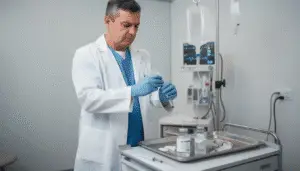Stem Cell Therapy For Neuropathy
Stem cell Treatment For Neuropathy targets nerve regeneration, addressing the root causes of pain, numbness, and discomfort.
Stem Cell Injection Therapy
Healing Nerve Damage
Neuropathy, often caused by conditions like diabetes or trauma, leads to nerve damage that can be painful and debilitating. Stem cell therapy introduces regenerative cells that help repair damaged nerves, reducing symptoms like tingling, pain, and numbness.

How Does Stem Cell Therapy Work For Neuropathy?
Stem cells have the ability to differentiate into nerve cells, promoting nerve regeneration and reducing inflammation around damaged nerves. By targeting the source of neuropathy, stem cell therapy offers a long-term solution for relief.


Benefits:
Stem cell therapy is designed to meet your unique needs, depending on the cause and severity of your neuropathy. This ensures that nerve damage is addressed effectively, offering relief from chronic pain and improving overall quality of life.
- Promotes Nerve Regeneration: Repairs damaged nerves to relieve symptoms like pain and numbness.
- Reduces Chronic Pain: Addresses the root cause of neuropathic pain for lasting relief.
- Improves Nerve Function: Enhances the overall function of damaged nerves, restoring sensation.
- Non-Invasive Treatment: Offers a natural and minimally invasive option for managing neuropathy.
- Long-Term Relief: Provides ongoing improvement rather than temporary pain management.
More Stem Cell Treatments
Stem cell therapy offers a natural way to heal and rejuvenate your body. Whether you’re looking to slow down the aging process, boost your immune system, or find relief from pain and chronic conditions like arthritis, stem cells can help. These treatments tap into your body’s own power to repair and restore.
FAQ's
What is stem cell therapy?
Stem cell therapy uses the body’s natural cells to repair, regenerate, and heal damaged tissues. These cells have the unique ability to transform into different types of cells your body needs, like muscle, bone, or nerve cells. It’s a minimally invasive treatment that taps into the body’s own healing power to treat a range of conditions from injuries to chronic diseases.
How does stem cell therapy work?
Stem cells are collected from your own body (usually from bone marrow or fat tissue) or from other sources, then reintroduced into areas that need repair. Once there, these cells stimulate healing, reduce inflammation, and promote the regeneration of healthy tissue. Essentially, they target the damaged areas and work to restore proper function.
What conditions can stem cell therapy treat?
Stem cell therapy can help with a variety of conditions, including joint pain, arthritis, autoimmune diseases, neuropathy, chronic injuries, and even sexual dysfunction. It’s also used to improve immune response, manage pain, and help the body recover faster after trauma or surgery.
Is stem cell therapy safe?
Yes, stem cell therapy is generally considered safe, especially when using your own cells. Since it’s a natural process and minimally invasive, there’s a lower risk of complications compared to surgeries or medications. However, like any medical treatment, it’s important to discuss potential risks with your doctor.
How long does it take to see results?
Results vary depending on the condition being treated and the individual. Some people notice improvements within weeks, especially with pain relief and mobility. For others, the full benefits of tissue regeneration and healing can take a few months. It’s a gradual process, but the results are long-lasting.
How many treatments will I need?
The number of treatments varies depending on your condition and how your body responds. Some patients experience significant improvement after just one session, while others may need multiple treatments for the best results. Your doctor will personalize a treatment plan based on your specific needs.
Caution: The treatment may not be effective or appropriate for all patients, additional side effects may occur, and all patients should talk to their physician to learn more about the treatment and potential risks.




